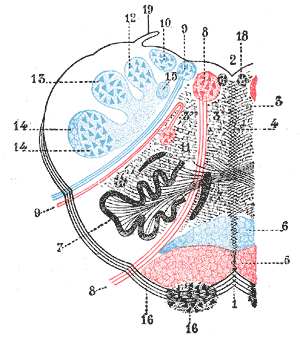Rostral ventromedial medulla
Rostral ventromedial medulla
The rostral ventromedial medulla (RVM) is a critical structure within the brainstem that plays a significant role in the modulation of pain. It is located in the medulla oblongata, which is part of the hindbrain. The RVM is involved in the descending control of nociception and is a key component of the pain pathway.
Anatomy[edit | edit source]
The RVM is situated in the ventral part of the medulla oblongata, near the midline. It includes several important nuclei, such as the nucleus raphe magnus and the adjacent gigantocellular reticular nucleus. These nuclei are involved in the modulation of pain signals that are transmitted from the spinal cord to the brain.
Function[edit | edit source]
The primary function of the RVM is to modulate pain through descending pathways. It exerts its effects by releasing neurotransmitters such as serotonin and norepinephrine, which can inhibit or facilitate pain signals. The RVM receives input from higher brain regions, including the periaqueductal gray (PAG) and the hypothalamus, and sends projections to the dorsal horn of the spinal cord.
Pain Modulation[edit | edit source]
The RVM plays a dual role in pain modulation, capable of both inhibiting and facilitating pain. This dual role is mediated by different populations of neurons within the RVM:
- On-cells: These neurons facilitate pain transmission and are activated during pain.
- Off-cells: These neurons inhibit pain transmission and are typically active during pain relief.
The balance between these two types of neurons determines the overall effect of the RVM on pain perception.
Clinical Significance[edit | edit source]
Dysfunction in the RVM has been implicated in various chronic pain conditions. Abnormal activity in the RVM can lead to enhanced pain sensitivity, a condition known as hyperalgesia, or a reduced pain threshold, known as allodynia. Understanding the role of the RVM in pain modulation can help in developing targeted therapies for chronic pain management.
Research[edit | edit source]
Ongoing research is focused on understanding the precise mechanisms by which the RVM modulates pain and how it interacts with other components of the pain pathway. Studies are also exploring potential therapeutic targets within the RVM for the treatment of chronic pain conditions.
See Also[edit | edit source]
References[edit | edit source]
External Links[edit | edit source]
Navigation: Wellness - Encyclopedia - Health topics - Disease Index - Drugs - World Directory - Gray's Anatomy - Keto diet - Recipes
Search WikiMD
Ad.Tired of being Overweight? Try W8MD's physician weight loss program.
Semaglutide (Ozempic / Wegovy and Tirzepatide (Mounjaro / Zepbound) available.
Advertise on WikiMD
WikiMD is not a substitute for professional medical advice. See full disclaimer.
Credits:Most images are courtesy of Wikimedia commons, and templates Wikipedia, licensed under CC BY SA or similar.Contributors: Prab R. Tumpati, MD

